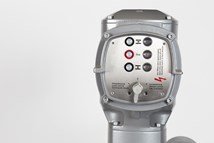Curtiss-Wright and Teledyne FLIR Defense Sign Agreement to Provide Unmanned Systems to the U.S. Nuclear Power Market and DOE
As the largest ground robot supplier to the U.S. Department of Defense, Teledyne FLIR has delivered more than 20,000 unmanned platforms to over 50 countries.
#automation #VMAnews

Curtiss-Wright Corporation has entered into an agreement with Teledyne FLIR Defense to supply unmanned systems and integrated solutions to the U.S. nuclear power market and the Department of Energy (DOE). Mobile unmanned systems (MUS), including drones, robotics and submersibles, play a critical role in industrial and defense applications by automating operations and eliminating the need for humans to perform tasks in hazardous conditions.
“Curtiss-Wright is committed to modernizing plant systems and equipment for the U.S. nuclear fleet and DOE, and this agreement is an important step in expanding our portfolio of unmanned systems technologies,” said Lynn M. Bamford, president and CEO of Curtiss-Wright Corporation. “By partnering with Teledyne FLIR Defense, a leader in unmanned systems technologies, we are able to leverage our established leadership in the nuclear power generation market and offer our customer base cutting-edge solutions that enable autonomous operations, increase worker safety and reduce costs for plant operators.”
Curtiss-Wright is one of the leading global suppliers to the nuclear power industry. Its products are installed in every nuclear plant in North America and we have a growing presence supporting global new reactor construction, including large light water reactors, advanced reactors and small modular reactors. In its 60-year history supporting the commercial nuclear power market since inception, the company has developed a large installed base supported by strong customer relationships. Teledyne FLIR has direct experience in the nuclear market, including a mature install base of ground robotics in several commercial nuclear power plants and Department of Energy sites, as well as international projects.
“We are pleased to be working with Curtiss-Wright to advance the use of unmanned systems in nuclear and other power facilities where they can make a tremendous difference in keeping human operators out of harm’s way and improving efficiencies,” said Tom Frost, vice president of Unmanned Ground Systems at Teledyne FLIR Defense.
As the largest ground robot supplier to the U.S. Department of Defense, Teledyne FLIR has delivered more than 20,000 unmanned platforms to over 50 countries. Its products include unmanned aerial systems, unmanned ground systems, and integrated solutions, including advanced thermal cameras and intelligent sensors used to detect chemical, biological, radiation, nuclear and explosive threats.
For more information about Curtiss-Wright’s Nuclear Division, visit www.cwnuclear.com.
RELATED CONTENT
-
Regulators versus Control Valves: What’s the Best Fit?
The combination of North American shale fields that continue to fuel high levels of new domestic oil and gas projects and ongoing global efforts means the need for efficiency in instrumentation selection has never been higher.
-
The Rationale Behind Valve Characteristics
Back in the “early days,” we were taught that, to properly control flow, we should select a linear valve characteristic when the valve controls more than 25% of the piping system pressure drop at full flow.
-
Stop Check Valves
Stop check valves are vital to several industries to protect boilers and other equipment.








 Unloading large gate valve.jpg;maxWidth=214)


